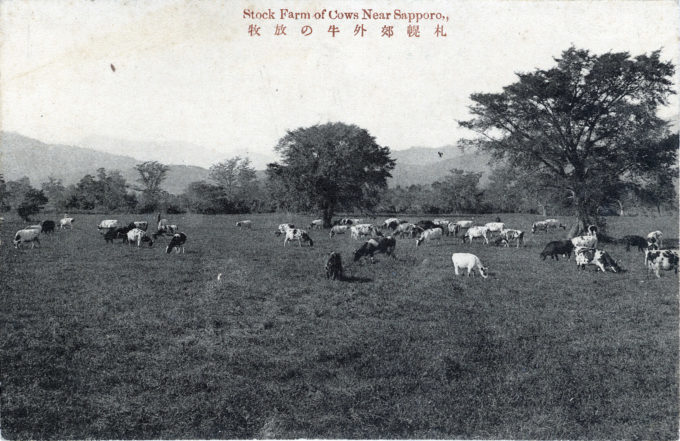“In contrast with Western agriculture based on live stock we have in Japan an agriculture based on rice. But a section of the Japanese agricultural world turns its eyes longingly to mixed farming, and so, when I returned to Sapporo from my trip to the north of Hokkaido, I was taken to see a Government stock farm – with a smoking volcano in the background.
“Hokkaido has four other official farms, one belonging to the Government and one for raising horses for the army. I was shown, in addition to horses, Ayrshire, Holstein and Brown Swiss cattle, Berkshire and Yorkshire pigs and Southdown and Shropshire sheep in good buildings. I noticed two self-binders and a hay loader and I beheld for the first time in Japan a dairy maid and collies – one was of a useless show type.
“On the Government farm I found excellent cheese and butter being made. Untravelled Japanese have the dislike of the smell of cheese that Western people have of the stench of boiling daikon [Japanese radish]. Nor is cheese the only alien food with which the ordinary Japanese has a difficulty. The smell of mutton is repugnant to him and he has yet to acquire a taste for milk.
“The demand for milk is increasing, however. The guide books are quite out of date. Nearly all the milk ordinarily sold for foreigners and invalids is supplied sterilised in bottles. On the platforms of the larger railway stations bottles of milk are vended from a copper container holding hot water. In places where I have been able to obtain bread I have usually had no difficulty in getting milk.
“Butter in country hotels is usually rancid, for the reason, I imagine, that it is carelessly handled and kept too long and that few Japanese know the taste of good butter. The development of a liking for bread and butter is obviously one of the conditions of the establishment of a successful animal industry. Condensed milk is sold in large quantities, but chiefly to supplement infants’ supplies and to make sweetstuff. The 1919 production was estimated at 57 million tins.”
– The Foundations of Japan, by J.W. Robertson Scott, 1922

“Stock farm of cows near Sapporo”, Hokkaido, c. 1920. In 1876, the Japanese government hired William S. Clark, former president of the Massachusetts Agricultural College (now the University of Massachusetts-Amherst) as a foreign advisor to establish the Sapporo [Hokkaido] Agricultural College. During his eight months in Sapporo, Clark made a significant impact on the scientific, agricultural and economic development of the island of Hokkaido … and also made a lasting impression on Japanese culture. His parting words to his Japanese students, “Boys, be ambitious!*”, have become a nationally-known motto in Japan [少年よ大志を抱け Shōnen yo, taishi o idake].
See also:
“The Five Stock Exhibition of Hokkaido,” c. 1920.
“Live Stock Exposition”, Ueno Park, Tokyo, 1919.
“Hokkaido Imperial University”, Sapporo, c. 1920.
“Although keeping milk cows on farms in modern Japan began with the Meiji Restoration of 1867, it continued to be an isolated phenomenon for some years thereafter. Milk was consumed more for medicinal purposes than as a part of the general diet. The taste for dairy products developed slowly and became significant only in recent years.
“However, as an aspect of modernization, the government began to encourage the keeping of milk cows. Initially, they were imported and introduced at the peripheries of large cities such as Tokyo and Osaka, where milk factories rather than dairy farms were established. Thus, in contrast to Western countries, the raising of milk cows did not evolve around the idea of a dairying industry but that of a milking industry.
“… But the keeping of milk cows by farmers spread slowly. The animals were kept strictly as a side-business to rice growing. Milk cows, usually one or two per farm, were scattered about widely and collection of milk was a serious problem.
“The purchase of the animals was very difficult, as the average farmer cultivated about two acres and had little capital. Furthermore, practically all of the enriched feedstuffs had to be purchased, usually as imports from other countries … Farmers could not afford to devote any part of their small farms to fodder crops.
“Until the 1920’s there was no area in Japan which could be identified as a dairying region. However, as more government attention was given to the northern island of Hokkaido, Japan’s last frontier region, and as more settlers moved there, a definite emphasis upon dairying began, especially in northern and eastern Hokkaido where the climate is cool and foggy and summers are short. Similar conditions exist in eastern Tohoku, and there too the government has been urging the development of a dairying region.
“… Being relatively distant from the large urbanized areas in southwestern japan, these northerly regions have stressed the production of cheese and butter and other processed dairy products.”
– “The Dairying Industry of Japan”, by George H. Kakiuchi & Kazuo Ninomiya, Yearbook of the Association of Pacific Coast Geographers, Vol. 32, 1970


Pingback: “The Miyagi, An Agricultural College”, Sendai, Miyagi Prefecture, c. 1910. | Old TokyoOld Tokyo